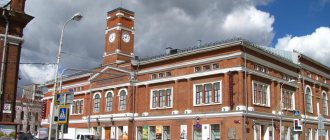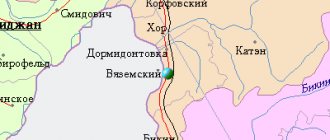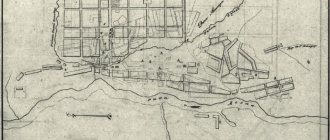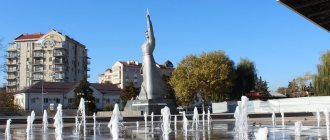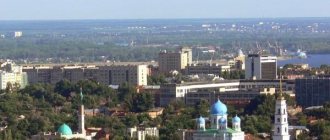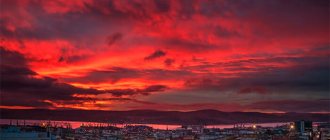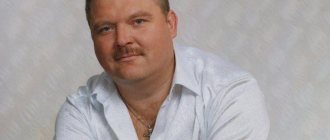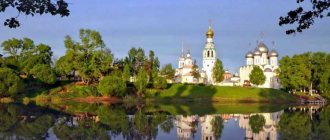We will talk about another agglomeration, tightly connected with the textile industry of Greater Moscow. However, the main attractions of Noginsk now tell more about the page of the biography that precedes the industrial stage. That is, about the “through and through” church Bogorodsk. There are so many temples here that we decided to present to your attention only the most famous ones. After all, the second “highlight” should also be shown - picturesque public gardens with memorable monuments. And also points where young tourists will tell their parents “Let’s stay!”
What holiday is it today?
February 10, 2022, Thursday
Today are holidays, events: Diplomat's Day Tomorrow: World Sick Day Discovery of insulin
Today is the Orthodox holiday: St. Ephraim the Syrian. Venerable Ephraim of Novotorzhsky. Venerable Ephraim of Pechersk, Bishop of Pereyaslavl. Venerable Theodosius of Totem, Spasosumorin of the monastery, leader and founder... Tomorrow: Transfer of the relics of the holy martyr Ignatius the God-Bearer. Saints Gerasim, Pitirim, Jonah, bishops of Great Perm, Ustva...
Today is a national holiday: Ephraim's Day... Tomorrow: Lawrence's Day
Seasons
Seasons, four periods of the year (spring, summer, autumn and winter) characterized by certain average temperatures. The period during which the Sun passes through one of these sectors is called the season. Spring in the Northern Hemisphere and autumn in the Southern Hemisphere begin when the Sun passes through the initial circle of declination and its right ascension is 0° (vernal equinox). Summer in the Northern Hemisphere and winter in the Southern Hemisphere occur when the sun's right ascension is 90° (summer solstice). Autumn in the Northern Hemisphere and spring in the Southern Hemisphere begin when the sun's right ascension is 180° (autumnal equinox). The beginning of winter in the Northern Hemisphere and summer in the Southern Hemisphere is considered to be the winter solstice, when the direct ascension of the Sun is 270°... Next: Seasons. Russian folk calendar. Monthly words...
Folk calendar about every day
Every day one season always replaces another and this determines a person’s way of life. In connection with this, a folk calendar was formed in which there were practically no nameless, unmarked days. Every day was special, had its own purpose. All this was determined by climate conditions and astrological phenomena.
A calendar is a system for counting periods of time. The first calendars arose a long time ago, in ancient times, because there was a need to measure time. The word calendar comes from the Latin words caleo - to proclaim and calendarium - debt book. This is due to the fact that in Ancient Rome the beginning of each month was especially proclaimed, and because it was customary to pay debts on the first day of the month. Different peoples counted time differently. Some calendars are based on the changing phases of the moon - lunar calendars; in others - the change of seasons - sunny; in others, the length of the year was coordinated with the change of seasons, and the counting of months was associated with the phases of the Moon. Such calendars are called lunisolar.
In Rus', the calendar was called a monthly calendar. Every day, the month book covered the entire year of peasant life, “describing” day by day, month after month, where each day had its own holidays or weekdays, customs and superstitions, traditions and rituals, natural signs and phenomena. The cyclical nature of the calendar is reminiscent of human life, where spring is youth, summer is heyday, autumn is the time of harvesting fruits (it’s good if there are some, otherwise you can live your life without collecting fruits), winter is the time of wisdom and peace. This cyclicality and rhythm determined the way of life of the farmer. The folk calendar was an agricultural calendar, which was reflected in the names of the months, folk signs, rituals and customs. Even the determination of the timing and duration of the seasons is associated with real climatic conditions. Hence the discrepancy between the names of the months in different areas... Next: Folk calendar...
What to see in Noginsk with children
Einstein Museum
Who said that physics is a very boring science? Among the list of “children’s” attractions in Noginsk, you will come across an institution on Revsobraniy Street, 2G. All the wonders of physical phenomena are collected here: a tabletop tornado, indoor lightning, pocket perpetual motion machines, 4 quite funny Archimedes levers, an “entertaining” plasma ball, tools for creating optical illusions and even easily controlled “soap-building” material. There are 50 exhibits in total. And they all fit into a completely modern building. Entrance to the interactive kingdom of the “fundamentals” of all sciences will cost 350-380 rubles. Maybe this is more expensive than the cost of visiting some state museum. But a young guide is provided to you free of charge. He will tell you about the quest room. And for the event there you need
The benefit of an entertainment center is that kids or schoolchildren (and you with them) can play billiards, slot machines, draw, watch a giant TV, jump, and roller skate in one place. Look at the artistic knitting of figures from balloons, and also eat or drink something memorable and incredibly tasty (baked goods, cocktails, etc.). It makes sense to order any children's party. The chefs, DJs and animators of the Coco Bongo cafe are here to help you. The center is located on the 1st floor of a large “modern” building, built in the suburban residential complex “Polet” (Poselkovaya St., 72). The cost of an hour of various entertainment services does not exceed 400 rubles. Nearby is the huge Annunciation Arboretum. In it (along the road) there is an impressive example of an anti-tank hedgehog (preserved from the time of the Battle of Moscow) and a stop.
Mini-zoo “Russian Compound”
If you have already decided what to see in Noginsk in two days, then leave a couple of hours for this interesting place, located in the residential area of Zhilino (6 km from the city center, the territory of the Yakhonty country hotel). An untouched forest, a mill, a cafe in the form of old Russian gazebos (there is even a samovar and bagels) will create a pleasant atmosphere. It is precisely in such an environment that one should communicate with “our smaller brothers.” This crazy company includes rabbits, goats, forest flying game and poultry. In another stall, completely obedient horses are waiting. If necessary, they will be quickly harnessed. All prices are negotiable. Feed store right on site. Opening hours: from 10 to 20 hours (break from 13 to 14). For hotel guests, many things are provided free of charge.
In winter, people enjoy downhill skiing and horse-drawn sleigh rides. In general, if you want to find yourself in the distant past, here’s a real Russian courtyard...
All the attractions of Noginsk described here will allow guests of different genders and ages to spend their weekend in a fun and educational way, gaining many new impressions.
Fishing calendar for every day
The fishing calendar should not be taken as an absolutely indisputable truth. Fish biting is greatly influenced by a whole range of natural factors, as well as the influence on the nature of man himself. You must not forget that the fish’s bite depends and is determined not only by the calendar dates and biological cycles of their life, reflected in the calendar, but also, no less, by the state of their habitat; the bite also depends on weather conditions: air and water temperatures, cloudiness, wind direction and strength, etc... Next: Fishing calendar...
Council of Deputies. By the end of the year, Noginsk residents must decide: Noginsk or Bogorodsk?
The draft budget, tax rates, improvement rules, the procedure for identifying the population’s opinion on renaming the city of Noginsk are only part of the issues on the agenda of the next meeting of the Council of Deputies of the Bogorodsky City District, which took place at the beginning of last week.
About the budget
“And, definitely, the main issue on the busy agenda was the decision “On the district budget for 2022 and the planning period of 2022 and 2021,” said Vladimir Khvatov, Chairman of the District Council.
The head of the financial and treasury department of the district administration, Irina Safronova, reported the main parameters of the budget for the next year. Let's note some of them.
— According to the forecast of socio-economic development, sustainable development and growth in the volume of shipped goods are maintained in the district. Growth in 2022 will be about 11%, or almost 12 billion rubles, the growth of investments in fixed assets will be almost 7%, which is more than 1 billion rubles,” said Irina Safronova. — More than 2 thousand jobs are created in the district every year. The projected salary growth is about 7%. This figure is very significant for the district budget, since personal income tax makes up a significant part of tax and non-tax budget revenues - 43%.
It was also noted that the annual increase in tax payments since 2015 has been 10-12%; an increase of about 10% or 181 million rubles is planned for 2022.
Property taxes - land tax and personal property tax - account for more than 25% of budget revenues.
Non-tax revenues - income from the rental and sale of property, fees for negative impacts on the environment - will amount to about 20% of budget revenues. At the same time, a slight decrease in revenues is predicted due to changes in legislation in the area of calculating these payments.
Thanks to the support and assistance of the government of the Moscow region, the district treasury will be significantly replenished, and this will provide great opportunities for creating comfortable living conditions in the Bogorodsky district. Grants, subventions and subsidies from the regional budget for the implementation of state programs will amount to several billion rubles. The greatest weight in subsidies from the regional budget is given to financing the construction of socially significant facilities, the development of engineering infrastructure and energy efficiency, Safronova added.
Budget of the Bogorodsky district for 2022:
- 9 billion 908 million rubles. - income
- 10 billion 92 million rubles. - expenses
The budget is formed on a program-target basis; 19 municipal programs are being implemented in the district. The largest expenses are occupied by the education sector, more than 48%, thanks to the regional budget, investments in municipal property have a large share (17%), expenses for housing and communal services, road activities, landscaping - 12%, culture, physical education, sports and social policy - 11.7%, ensuring the activities of local governments - 6%, from 0.5 to 1% are expenses for the media, national security, supporting the activities of the MFC and servicing municipal debt.
In 2022, the construction of a kindergarten in Noginsk on the street will be completed. Klimov for 260 places, an extension to school No. 18 for 350 places, construction of an extension for 400 places to school No. 1 begins, plans include an extension to school No. 5 and the construction of a school for 1,100 places in the microdistrict. Zarechye-2.
In Noginsk, the reconstruction of the Znamya stadium and the construction of a sports complex with an ice arena on the street will also continue. Klimov, FOC "Akrikhin" in Staraya Kupavna. The construction of all these facilities is carried out on the terms of co-financing from the regional and local budgets, in a ratio of 95 to 5, respectively.
Among the engineering infrastructure facilities, it is planned to build a sewerage station in the village. Kudinovo, water intake point in the village. Timokhovo, modular boiler house in the village of Shchemilovo.
Oleg Kartsov, Chairman of the Budget Commission:
— In general, the budget of the Bogorodsky urban district is formed so that we can look into the future with enough confidence. It is socially oriented, more than 57%. Much attention is paid to the issues of engineering infrastructure, urban environment, architectural appearance, and most importantly, growth points for the Bogorodsky region are outlined.
Also, by decision of the deputies, changes were made to the budgets of the municipalities of the village. p. Yamkinskoye, city village named after. Vorovskogo, Elektrougli, Noginsk, these settlements will be fund managers until the end of 2022. From 2022, the budget of the Bogorodsky District will be unified.
About taxes
In connection with the transformation of the Noginsky municipal district into the Bogorodsky urban district, a single tax rate is established for the property of individuals.
Tax rates in relation to taxable objects, the cost of each of which does not exceed 300 million rubles, are established in the following amounts (based on the cadastral value):
- 0.1% - for apartments and parts of apartments, rooms,
- 0.3% - for residential buildings and parts of residential buildings, unfinished construction projects, unified real estate complexes, garages, parking spaces, outbuildings or structures, the area of each of which does not exceed 50 square meters. m., located on plots for personal farming, gardening, gardening, etc.
- 0.5% - for other objects.
- 2% - for taxable objects whose cadastral value exceeds 300 million rubles.
It was decided to exempt the following from payment of property tax for individuals:
- One of the parents of a large low-income family whose average per capita income is below the subsistence level (one object at the request of the taxpayer).
- Single parents with minor children and members of the district Department of Social Protection of the Population.
- orphans
- children left without parental care.
The taxation system in the form of a single tax on imputed income for certain types of activities in the Bogorodsky urban district remains unchanged.
The land tax rate will be:
- 0.3% of the cadastral value: plots occupied by housing stock, engineering infrastructure of housing and communal services, agricultural lands, as part of agricultural use zones, plots acquired for individual housing construction, subsidiary farming, gardening, truck farming, livestock farming, summer cottage farming etc.
- 1% of the cadastral value of land under garage construction projects, individual and cooperative garages.
- 1.5% of the cadastral value for agricultural land plots not used for their intended purpose and other plots.
The head of the district, Igor Sukhin, made a proposal to work out the provision of tax benefits to certain categories of citizens.
The decisions of the deputies also affected property issues, so the base rental rate for non-residential premises remains unchanged at 2,600 rubles. per sq. m per year. This decision is aimed at supporting small and medium-sized businesses in the district.
Landscaping rules
Deputy head of the district Sergei Kolesnikov submitted to the vote of deputies the rules for improvement in the territory of the Bogorodsky district. Such rules were approved in 2015, but, in fact, did not work. The approved parameters of the rules were supplemented by a number of changes. Thus, newly constructed (or reconstructed) residential buildings and public buildings must be equipped with a set of landscaping elements. This includes complete asphalting of the territory, parking spaces, sports and children's playgrounds, lighting, installation of small architectural forms, landscaping. In addition, any facilities must be equipped with means of access for people with limited mobility. The deputies supported the rules, now the main thing is that they are followed.
Noginsk or Bogorodsk?
In addition, the deputies decided on the need to approve the procedure for identifying the population’s opinion on renaming the city of Noginsk and returning its historical name Bogorodsk.
Igor SUKHIN, head of the Bogorodsky urban district:
— One of the growth points of the Bogorodsky District is the development of a tourism cluster; on the territory of Noginsk there are Morozov barracks, which, fortunately, remained intact; many would be interested in them; we have the Volkhonka Arboretum and many other places attractive to tourists. The renaming of cities - St. Petersburg, Yekaterinburg - gave them impetus for development. We will involve everyone in this issue, hold a round table, we plan to ask the majority of the population for their opinion on renaming Noginsk to Bogorodsk.
— In this matter, the point of view of the residents will be of paramount importance! – added Vladimir Khvatov, “that’s why it is necessary to prepare a legal framework at the district level for the upcoming large-scale survey of Noginsk residents!
Borodina Ekaterina Yurievna
Source:
https://innoginsk.ru/novosti/obschestvo/sovet-deputatov-do-konca-goda-noginchane-dolzhny-reshit-noginsk-ili-bogorodsk
Orthodox calendar about every day
Orthodox calendar: Orthodox, Church and Christian holidays.
The church year is an alternation of weekdays and holidays. On weekdays, a person is called to work “by the sweat of his brow to earn his bread.” Holidays are given in order to feel liberation, to rise above the bustle and routine of the world, to feel involved in the highest of worlds, “where there are no illnesses, sorrows and sighs, but endless life.” Since ancient times, holiday cycles have been associated with the seasons. The pagans associated them with the worship of the forces of nature, the cult of which in the Old Testament was replaced by gratitude to the Creator for the universe. And although the connection between holidays and the seasons has not completely lost its power, since God is present in everything, in the plant and animal world, in human works, it nevertheless faded into the background, giving way to a spiritual foundation built on the Sacred Scriptures. The history of Orthodox holidays dates back to the times of the Old Testament. Each of the Orthodox holidays is dedicated to the remembrance of the most important events in the life of Jesus Christ and the Mother of God, as well as the memory of saints... Next: Orthodox calendar...
Russian folk calendar for every day
The word “sign” comes from the word “notice”, i.e. observe. As a result of observing what happens around a person every day, he accumulates life experience. This knowledge was passed down from generation to generation, carefully preserved and people trusted it as a sacred book. Many signs have come to us from the depths of centuries without losing their knowledge. Each of us is free to choose: to dismiss all this as an absurd superstition or to take a closer look at the signs and take the centuries-old experience of generations more seriously. Most of us, when taking exams, ask them to scold them, boasting about some kind of good fortune or luck, spit so as not to jinx them or knock on wood, take a detour if a black cat crossed the road, are afraid of the number 13 and much more. And who among us does not have lucky things, numbers? Who has never resorted to the help of fate at least once in their life, who has not believed in secrets? It’s as if everything connected with signs is hidden somewhere deep in our subconscious. Often we remember them mechanically, unconsciously, or just as a joke. But, undoubtedly, the signs contain a lot of accurate knowledge and practical wisdom of our ancestors. They cover all the characteristic, often difficult to perceive, natural phenomena. Signs have preserved a lot of what was in old folk holidays and customs; they help predict the weather, grow crops... Next: Folk signs...
The most beautiful places in Noginsk
All the sights of Noginsk that we see on most online resources or on TV are “business cards”. And they are touched upon in this chapter of our longread.
Fontannaya Square and the immediate surroundings
On this spot (located at the intersection of Gorky, International and Sovetskaya streets) you will have the opportunity to appreciate another advantage of the city - a huge cascade of fountains. They go along the perimeter of the ponds, which have the appearance of a strict pattern in plan. Water rushes out of hundreds of nozzles at once. The hydro-engineering attractions of Noginsk create coolness in the heat, causing genuine delight in children. There is a lot of granite, elegant benches, fences and lanterns made with artistic forging. By the way, on the nickel decorated with columbariums, French lawns and elegant sidewalks, you also have access to the Drama and Comedy Theater. This building was erected in the New Art Nouveau style. And across the road the corner where all the WWII memorials are concentrated will “look” at you. Including the already mentioned anti-aircraft gun and another chapel. The presented fragment of the central blocks is recognized as the most photogenic (by both citizens and guests of Noginsk).
Main city park and Fairy Tales Alley
By sending the request “What to see in Noginsk?”, you can get this name. Or rather, two. The fact is that the eastern “portal” to the recreation area (the name of which is in the top line) is located in the Alley of Fairy Tales. It is at the intersection of Komsomolskaya and Lesnova streets. Here you will find a bronze squirrel gnawing on golden nuts (sitting in a cage), and 7 dwarves with Snow White, and even a Russian stove. Heroes of Soviet cartoons lounged imposingly on the benches. In terms of vegetation, the central central park is a mixed forest (birch, pine, alder, aspen and spruce live here). Among several sidewalks there were attractions - for small children, as well as teenagers and adults who are not afraid of any extreme sports. It is important that there is where to buy both drinks and sweets. You can actually find more serious food in one of the local cafes. Of course, toilets are also at your service. In the same area, a large... ruble hangs on one of the trees! There is a pond and a bridge nearby. In general, there are more than enough subjects for a photo shoot! The center of the park complex is the Good Angel of Peace, installed on a high pillar. There is a round colonnade around it. There is a recreation center. It remains to add: the oldest (entirely wooden) residential areas are located nearby. And they contain examples of the austere architecture of the former Bogorodsky district. The gymnasium building was once built in the “flaming” Art Nouveau style. It still performs its intended functions today.
Near the bus station: monument to Victor Nogin and Karl Marx Square
The rating of “iconic sights of Noginsk” continues with another feature – very beautiful spaces located on both sides of the main bus station. In front of the transport terminal is the Nogina park. Walking along it, you immediately notice Viktor Pavlovich himself. A Marxist philosopher, who after the Revolution became People's Commissar for Trade and Industry, together with Kamenev and Rykov, he opposed Lenin's “April theses”. Nevertheless, he became the first Bolshevik to achieve the position of chairman of the Moscow Council of Workers' Deputies. His second well-known merit was lobbying the interests of the Bolsheviks in the Pre-Parliament at the end of September 1917. It played one of the fateful roles in the process of the RSDLP (b) seizing power in the Soviets (after October). The merits of the figure made it so that his name was awarded the honor of becoming a toponym on the map. The head decorated with a “Chekist” cap looks intently at those who are not “unloaded” from the buses. Nogin's gaze is directed in the opposite direction - to the railway station. Just like the telegraph and the post office, this building is of greatest importance to any revolutionary. Moreover, suspicious people gather at the Vstrecha cafe.
To the east of the bus station, the tourist will find himself in another green area - K. Marx Square. In addition to the familiar bearded image of the author of “Capital”, in the named recreation there are four stone memes – to Victims of Political Repression, Prisoners of Fascism, WWII Warriors and Internationalist Soldiers. People pray for everyone in the chapel. Several tiled sidewalks, 4 columbariums, well-grown trees.
Exhibition Center "House of Artists"
This landmark of Noginsk is known throughout the Moscow region. Because famous brush and pencil masters in the Moscow region exhibit here. It deserves your attention for a number of reasons. The first is, of course, the paintings themselves. The second is unique fur coats for sale. The third reason to visit here with a camera is creative meetings not only with graphic artists, applied artists, sculptors and painters, but also theater and film actors. The establishment is located in the Volodarsky microdistrict, on Klimova Street, 35. This is a continuation of the embankment. Official “entry” into the exhibition hall costs 150 rubles. We look at fur coats for free.
The world's largest Oriflame factory
What to see in Noginsk, moving to the end along the famous (longest) Magistralnaya (3rd International) street? Of course, the production complex of the international company named in the title. This is the largest investment project in terms of volume (investment – 150,000,000 euros). The façade looks more like a shopping mall rather than an enterprise. The company's management also turned the industrial site into a site for tourist excursions. Visitors will not only be beautifully presented with the manufactured product in an amazing exhibition complex, but will even be shown how it is produced and how it is stored. The total area of the production complex is 26.5 hectares. Around it there is also a recreation area with greenery, fashionable benches and more. There are workshops not only for the production of cosmetic products themselves, but also for packaging for them. And also a noisy and massively armed logistics center. The warehouse looks even more majestic, the shelves of which “run away” to the height of a 5-story building. Are you a cosmetics lover? Then pay a visit to the local ice cream factory. But the Ministry of Health warns: this product is dangerous for your throat.
Holiday calendar, dates and events of the year
All state and professional holidays in Russia, including significant World and International holidays, and other equally interesting holidays and events about every day.
The holiday has always kept pace with the history of mankind. Social time can be divided into three types: everyday life (weekdays), weekends and holidays. Everyday life is a series of practices repeated day after day and every day (work). Weekends are regular breaks from the rush of everyday life. It is believed that on weekends a person should restore his strength after working days. Day off, non-working day. A holiday is a day of celebration established in honor or in memory of someone or something. A day or series of days celebrated by the church in memory of a religious event or saint... Next: Calendar...
Prayer book, Orthodox prayers for every day
Prayer is the most powerful means for healing all illnesses - both physical and mental. Prayers can be laudatory or grateful, petitionary and repentant. If we have offended God, sinned, we must ask Him for forgiveness, that is, repent. Such prayers are called repentant prayers. If everything is fine with us, if we and our loved ones are healthy and prosperous, if we have a place to live, something to wear, something to eat, we must glorify and thank God for this. Such prayers are called praise or thanksgiving. If some misfortune, illness, trouble or need happens, you need to ask God for help. Such prayers are called petitionary... Next: Orthodox prayers...
What to see in Noginsk in 2 days
Having an “extra” day will give you a chance to explore all the interesting things. Read how and what to see in Noginsk in 2 days:
- We save time: we start the promenade from the station area - that is, from the squares of Victor Nogin and Karl Marx, as well as the monument to the 209th regiment;
- on the way to the northwest you come across Fontannaya Square, the Drama and Comedy Theater;
- further along this course is Bugrov Square with a local history museum. It's time for lunch here;
- We recommend ending the day with a walk along the entire embankment – Epiphany Cathedral, Tikhvin Church, House of Artists, Church of the Matrona of Moscow, Lenin;
- the next day, start from the points where you need to go - the former Morozov estate, the Russian Compound (everything lies in the north-east direction);
- after lunch, the opposite half of the city - City Park, the Einstein Museum and the Jumanji shopping center. Have dinner there too;
- Before going to bed, we recommend the city park with the Alley of Fairy Tales and the Oriflame factory.
Zodiac, astrological, eastern calendar. Zodiac signs
In ancient times, to establish the calendar, priests used knowledge of the positions of all the planets. Before the reform of Peter 1, the New Year was celebrated on the Day of the Autumn Equinox. On this day, according to ancient legend, the most peaceful treaty was concluded between the Great Race (ancient Slavs) and the Great Dragon (ancient Chinese) and it was approximately 7518 years ago... For the ancient Slavs, the calendar month corresponded to the lunar cycle from new moon to new moon, taking into account such Thus, the relationship of the entire annual cycle with astronomical and natural phenomena. There was no coherent calendar system. The main natural phenomena are still considered to this day to be the days of the solar equinox and solstice - the Slavic holidays Maslenitsa, Kupala, Ovsen and Kolyada. But during the time of Peter 1, all ancient Slavic calendars were abolished and a new Western European calendar from the Nativity of Christ (Julian calendar) was introduced, while the beginning of the calendar was moved to January 1. The Julian calendar (old style) did not take leap days into account and accumulated one extra day every 128 years. After the October Revolution in 1918, the Gregorian calendar (new style) was introduced in Russia, according to which an amendment of 13 days was introduced. The calendar of the ancient Slavs was based on two planets: the Sun and the Moon. And now they don’t use anything at all. The calendar has become static. There is no such thing as the calendar, it turns out, resting on some planet. Nobody even knows about it. There are just some standard numbers, there are months and holidays. The calendar is based on the Sun and Moon. Why is this so? Because these two luminaries influence the Earth. The Earth revolves around the Sun, and the Moon revolves around the Earth. And these two luminaries create the atmosphere on the planet. From here the calendar is built... Next: Astrological calendar...
Main attractions of Noginsk
These completely different objects can be considered among the main beauties of the city.
Epiphany Cathedral and monument to Patriarch Pimen
It is more convenient to explore the “embankment” sights of Noginsk one after another, moving along the Klyazma. We recommend starting with a picturesque ensemble, made in eye-catching shades of white and blue. A colorful example of religious architecture appeared in 1876. It was built in the style of that era. The style is called Empire. Large, dome, columns, wide apse and 4-story bell tower, deliberately decorated with half-columns. Everything was within the framework of the building laws of that time. The religious institution is active. It runs a Sunday school and a library. The main shrine is the Tikhvin image of the Mother of God. The forerunner of the named structure appeared in the 17th century. Dedicated to Saint Nicholas. During the Soviet period, the building performed various unusual functions. Returned to believers only in 1989.
After walking literally 75 meters, the visitor will get acquainted with the figure of Patriarch Pimen. According to some information, Bogorodsk (now Noginsk) is the birthplace of this figure. In the world his name was Sergei Izvekov. Sergei became famous for his unusual role - he was the patriarch of All Rus' at a time when there was no longer any Rus'. He worked on the territory of an officially atheistic state - the USSR. We are talking about the 70s of the XX century. Captured in Soviet chronicles as the first Russian priest to speak at the UN against the nuclear arms race. He is also famous for convincing Mikhail Gorbachev to slowly return to the Russian Orthodox Church the rights and responsibilities that it had before 1917. The sculpture is made of bronze (Pimen is here in a canonical pose), and the pedestal is made of solid granite slabs. Steps made of the same material lead to this composition. The entire area described here is decorated with a well-groomed lawn, benches and flower beds.
The Epiphany Cathedral and the monument to Patriarch Pimen are historical landmarks.
Tikhvin complex: parish church, chapel and courtyard
What interesting things to see in Noginsk without leaving the embankment? 300 meters to the east the guest will reach another architectural ensemble. Its name is in the title. The temple itself appeared before everyone else. Back in 1846. At the moment we see his completely restored appearance. Red brick refectory, five-domed church of the Vladimir-Suzdal likeness. On the edge, a 3-tier bell tower characteristic of this “genre”. The reconstruction was based on photographs from pre-revolutionary times. The main relic is the relics of one of the Russian martyrs. His name was Konstantin Bogorodsky. Inside this building, in a hall with restored picturesque mosaics, regular services are held. In the courtyard, tourists will find two “fresh” remodels - a colorful church shop and a chapel erected in honor of Sergius of Radonezh. By the way, the holy spring gurgling not far from here was also christened with his bright name. Right next to the enterprise that produces rubber products. The Church of Our Lady of Tikhvin has a rich track record. Well-known priests in pre-revolutionary Russia cared for the parish here, and in 1891, Prince Sergei Alexandrovich and his wife Elizaveta Feodorovna visited the Tikhvin “abode of God”. She is the founder of several nunneries. In the desired space, the vacationer will find a pleasant-looking landscaped park. Its compositional center is the garden.
Church of the Assumption of the Virgin Mary and the monument to the 209th Bogorodsky Regiment
Having decided what to see in Noginsk in 1 day, you should definitely include this masterpiece on the list, located at the opposite (eastern) end of the agglomeration. It was built in the traditions of the same “empire” architecture (even the colors are like those of the buildings of the Epiphany Cathedral). The facility is located at the very beginning of Klyueva Street, sharing a courtyard with an equestrian club. Both buildings are again on the Klyazma embankment. The corner is very beautiful. On the presented site, vacationers will attend a divine service. And if there is no such desire, then they will buy an hour’s ride on a horse. Fortunately, there is somewhere to ride.
Probably, this memorial (installed at the intersection of Tikhvinskaya and 3rd International streets) tells travelers much more about the war years of Noginsk. But specifically about those when it was still called Bogorodskoye. The 209th Regiment got its name thanks to the “ancestor” of the current city. Here is a granite stone surrounded by a curb with a metal sign. It tells about the townspeople who fought on the fronts of the First World War. We are talking specifically about the period 1914 - 1916. Bogorodsk has produced enough heroes. Opposite is one of the two most popular bars here - “Roof”. On the other side (7 houses away) is the city hall. If military monuments are of particular interest to you, there is an anti-aircraft gun on Sovetskaya.
Bugrova Square and the Museum of Local Lore
Do you want to know what else to see in Noginsk? To do this, you will have to walk half a kilometer to the west - to the intersection with Trudovaya. The Noginsk Museum of Local Lore was built on the just-named roadway “artery”. But even earlier you will come across the forest park indicated first in the title. 5 alleys lead to the circle site. And in its center stands a sculptural work depicting Catherine the Great. Catherine II of Noginsk is mounted on a huge column and covered with gilding. So vandals cannot get to this invitingly sparkling city decoration. The granite pedestal stands on a concrete platform, and polygonal steps lead to it. The site itself is paved with paving slabs in such a way that under our feet we will see red rays diverging in different directions. Sit on a bench to quietly chew a pie or ice cream. Then to the mentioned NCM!
This exhibition consists of several halls filled with 10,000 storage items. Moreover, you will see the paintings in the hall, where you will pay 150 rubles for entry. The following departments are at your service: archeology and geology (“symbol” is a bust of a Cro-Magnon man, reconstructed by Gerasimov from skeletal remains), nature (dioramas of landscapes with stuffed animals and herbariums), WWII (military maps, personal belongings of officers and heroic soldiers, visual battle plans, remains of weapons, uniforms and, of course, photographic materials and documents found in the ground). Of particular interest is the branch of the educational institution - “Bogorodsk Post Station”. The exterior and interior of the Yamskaya station, thanks to which the village of Rogozhkino became a suburb, have been restored here.
Morozov's summer house - part of Glukhovsky Park
When thinking about what interesting things to see in Noginsk, do not pass by this “brand”. Its main difference is called the appearance itself. The heir of the famous Russian philanthropist, Arseny Ivanovich, once ordered the architect a mansion in the place that was eventually called Glukhovsky Park. This is a northeastern suburb, Krasnoslobodskaya street. The conversation turned to the authentic eastern shore of the Chernogolovsky pond, all the surroundings of which were once part of the Morozov estate. The summer house was created in the Dutch style. One-story, with an attic and a basement on the transverse axis. The facades are discreetly treated with stain, and their brick fragments are plastered. At the moment, one of the modern philanthropists is reconstructing the estate. The estate-reserve also includes a city park and ancient huts. Not far away (on Soviet Constitution Street) the domes of the Church of Konstantin Bogorodsky shine. This piece of Greater Moscow most convincingly sends us back to the past - from Noginsk to Bogorodsk.
Dream books online, interpretation of dreams
A dream book is nothing more than an interpreter of dreams and dreams, a translator of dreams. Since ancient times, people have been using dream books; dreams have always been given great importance, and people have often noticed the prophetic properties of some dreams. The dream book can become your faithful assistant every day and throughout your life, thanks to the dream interpreter you can always make the right decisions, the dream book will help you resist temptations in time, and will warn you against wrong steps and frivolous actions. Further…
